Text



“Modern art has led me to the comprehension and appreciation of Indian painting and sculpture. It seems paradoxical but I know for certain that had we not come away to Europe, I should perhaps never have realized that a fresco from Ajanta or a small piece of sculpture in the Musee Guimet is worth more than a whole Renaissance.”
- Amrita Sher-Gil (1913 -1941) was an Indian painter of Punjabi Sikh and Hungarian Jewish descent. She began her career in Parisian Bohemian circles, but in 1933 she began to be haunted by an intense longing to return to India feeling in some strange way there lay her destiny as a painter.
477 notes
·
View notes
Text

i fear no fate(for you are my fate,my sweet)
reference by 第1793个失踪的梦
3K notes
·
View notes
Text
*takes your hand* rapists don’t get punished in this country; most of the Terrible People you think should be “Locked Away Forever” won’t be. Prisons are stuffed with desperate poor people and people of color for things like Having Weed and Robbing a Gas Station Because They Were Desperate for Money or Being an Addict or, and this one’s my favorite, Being Black and at the Wrong Place and at the Wrong Time. Prison is a Farce; you’re not being protected from Bad People like the government wants you to believe, like use your brain and think about all the free labor prisons are getting out of these Black and brown men …
41K notes
·
View notes
Text
Love how tumblr has its own folk stories. Yeah the God of Arepo we’ve all heard the story and we all still cry about it. Yeah that one about the woman locked up for centuries finally getting free. That one about the witch who would marry anyone who could get her house key from her cat and it’s revealed she IS the cat after the narrator befriends the cat.
322K notes
·
View notes
Text
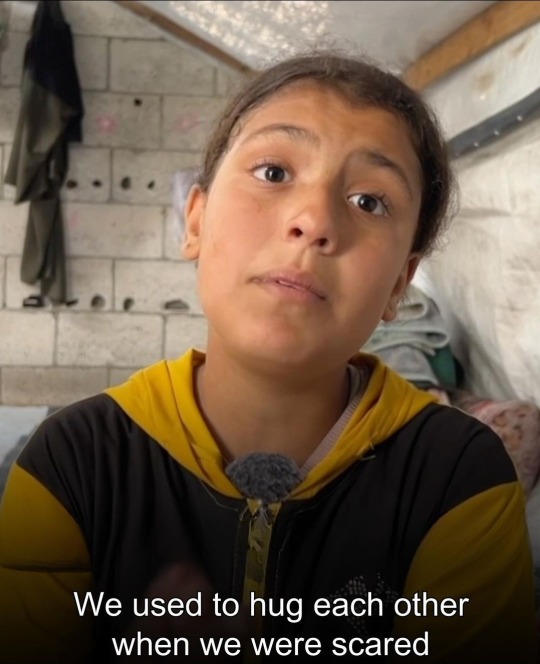
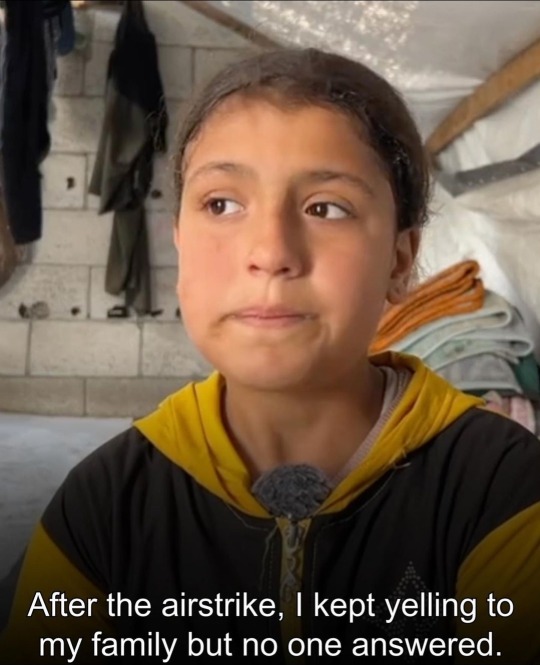

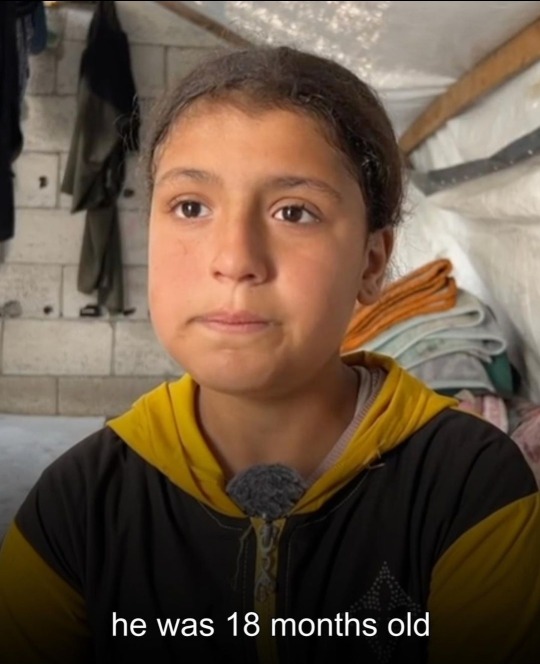


‘I wish for death’ - Twelve-year-old Alma says. She fled bombing and shelling twice before the third place they sheltered was bombed, She was rescued from the rubble only to find out both her parents and all four of her siblings had been killed. She found her 18-month-old brother in an unimaginable state. Her little brother was beheaded from the rubble after the IOF massacred them.
Source: BBC
41K notes
·
View notes
Text
he's the worst man alive, and I'm his favourite daughter, pretending I'm not scared</3
#why is my dad such an asshole#daddy issues#lol#god he's so scary#I'm so scared that I'll say the wrong thing#and then he won't love me anymore#I'm scared he'll talk to me like he talks to my mom#cus if he does#does that mean he doesn't love me anymore?#i need him to love me cus he's my dad#but i need him to stay away cus he's the worst man alive#i dont really pray#but i prayed god to give me strength#to just ask him for permission#and now I'm here#trembling in fear#i may be his favourite daughter#but how much is that really worth#when being his “favourite” is such a fragile little thing#what if he likes his girlfriend more than me?#i won't be his favourite anymore#and he'll talk to me like he talks to every woman#god im so scared
1 note
·
View note
Text
The best part was Yvette Clarke was disrupted as she was saying “Well i was raised in an activist household——“ An activist household taught you that voting to defund an organization that’s giving lifesaving aid to a population facing starvation, malnutrition, and a geocide is the right thing to do?
1K notes
·
View notes
Text
I'm sorry for being so sappy, but I wanted to show you guys something.

When I first donated to PCRF in December 2023, it was barely 10% close to its goal. Now in March 2024, they're also 100%. Everyone of you has helped support a better future for Gaza.
They're so close to their goal. Please donate or share this post so that they can get to their goal🇵🇸
77K notes
·
View notes
Text
Good Traits Gone Bad
Exploring good traits gone bad in a novel can add depth and complexity to your characters. Here are a few examples of good traits that can take a negative turn:
1. Empathy turning into manipulation: A character with a strong sense of empathy may use it to manipulate others' emotions and gain an advantage.
2. Confidence becoming arrogance: Excessive confidence can lead to arrogance, where a character belittles others and dismisses their opinions.
3. Ambition turning into obsession: A character's ambition can transform into an unhealthy obsession, causing them to prioritize success at any cost, including sacrificing relationships and moral values.
4. Loyalty becoming blind devotion: Initially loyal, a character may become blindly devoted to a cause or person, disregarding their own well-being and critical thinking.
5. Courage turning into recklessness: A character's courage can morph into reckless behavior, endangering themselves and others due to an overestimation of their abilities.
6. Determination becoming stubbornness: Excessive determination can lead to stubbornness, where a character refuses to consider alternative perspectives or change their course of action, even when it's detrimental.
7. Optimism becoming naivety: Unwavering optimism can transform into naivety, causing a character to overlook dangers or be easily deceived.
8. Protectiveness turning into possessiveness: A character's protective nature can evolve into possessiveness, where they become overly controlling and jealous in relationships.
9. Altruism becoming self-neglect: A character's selflessness may lead to neglecting their own needs and well-being, to the point of self-sacrifice and burnout.
10. Honesty becoming brutal bluntness: A character's commitment to honesty can turn into brutal bluntness, hurting others with harsh and tactless remarks.
These examples demonstrate how even admirable traits can have negative consequences when taken to extremes or used improperly. By exploring the complexities of these traits, you can create compelling and multi-dimensional characters in your novel.
Happy writing!
51K notes
·
View notes
Text
The symbolism of flowers
Flowers have a long history of symbolism that you can incorporate into your writing to give subtext.
Symbolism varies between cultures and customs, and these particular examples come from Victorian Era Britain. You'll find examples of this symbolism in many well-known novels of the era!
Amaryllis: Pride
Black-eyed Susan: Justice
Bluebell: Humility
Calla Lily: Beauty
Pink Camellia: Longing
Carnations: Female love
Yellow Carnation: Rejection
Clematis: Mental beauty
Columbine: Foolishness
Cyclamen: Resignation
Daffodil: Unrivalled love
Daisy: Innocence, loyalty
Forget-me-not: True love
Gardenia: Secret love
Geranium: Folly, stupidity
Gladiolus: Integrity, strength
Hibiscus: Delicate beauty
Honeysuckle: Bonds of love
Blue Hyacinth: Constancy
Hydrangea: Frigid, heartless
Iris: Faith, trust, wisdom
White Jasmine: Amiability
Lavender: Distrust
Lilac: Joy of youth
White Lily: Purity
Orange Lily: Hatred
Tiger Lily: Wealth, pride
Lily-of-the-valley: Sweetness, humility
Lotus: Enlightenment, rebirth
Magnolia: Nobility
Marigold: Grief, jealousy
Morning Glory: Affection
Nasturtium: Patriotism, conquest
Pansy: Thoughtfulness
Peony: Bashfulness, shame
Poppy: Consolation
Red Rose: Love
Yellow Rose: Jealously, infidelity
Snapdragon: Deception, grace
Sunflower: Adoration
Sweet Willian: Gallantry
Red Tulip: Passion
Violet: Watchfulness, modesty
Yarrow: Everlasting love
Zinnia: Absent, affection
48K notes
·
View notes
Text
eSims for Gaza is facing constant eSim shortages.
They get over a thousand requests for connection a day, but their email inbox is regularly sitting at 300-500 eSims. With the bombardment of Rafah and continual internet blackouts, the need for more eSims is particularly urgent.
Even if you have already sent an eSim or donated to an eSim donation drive, there is more you can do. The team is calling for people to campaign in their communities to help spread the word about eSims and encourage donations.
You can help by printing out posters and putting them up in local businesses, on telephone poles and notice boards, or wherever people are likely to see them.
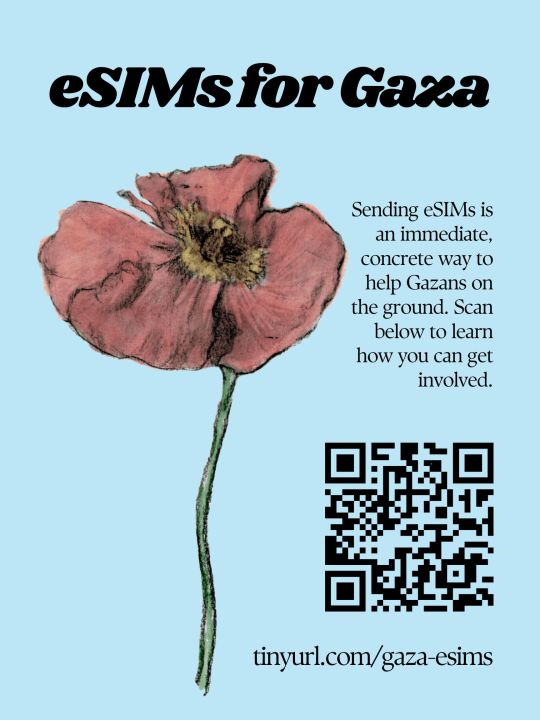
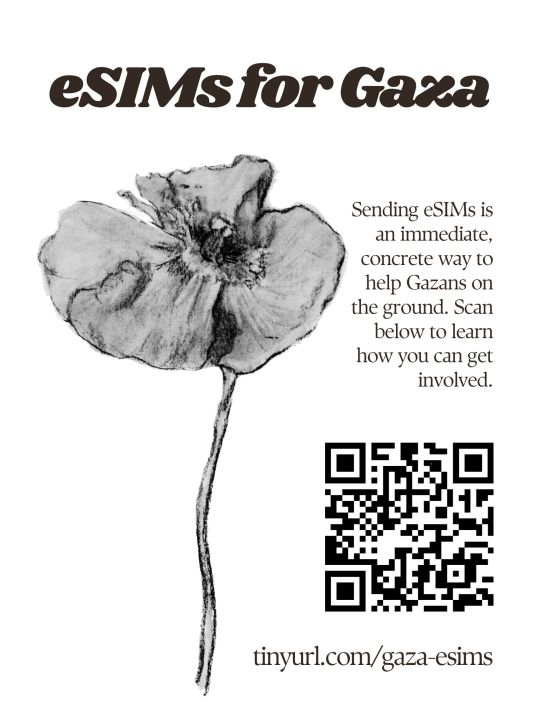
[ID: Poster headed “eSIMs for Gaza” with an illustration of a red poppy, a QR code, and a link to tinyurl.com/gaza-esims; copy reads “Sending eSIMs is an immediate, concrete way to help Gazans on the ground. Scan below to learn how you can get involved.” End ID]
Download color poster
Download black and white poster
Or make your own poster, pamphlet, or protest sign with one of these QR codes:


33K notes
·
View notes
Text
Draganski (2004) Study
So, at some point in the history of biology, scientists thought that there was a certain age at which your brain stopped growing and changing. However, as the 60s and 70s rolled in, research showed that the brain continues to be very dynamic; it keeps growing (and it also declines) depending on environment and cognition. This is called neuroplasticity (I mean- yeah no shit this study is under the neuroplasticity subtopic LMAO).
Two aspects of neuroplasticity are important for this study: dendritic branching and pruning. Neuroplasticity can be found in the mere strengthening of synapses due to Long Term Potentiation (LTP), which argues that the repetition of a task results in neuroplasticity; it also leads to dendritic branching (when neurons get more branches, so they have a bigger surface area and they can connect to more neurons), which in turn leads to an increase in neural density (i.e. you get more braincells! finally). When there isn't any potentiation, so after you stop doing something, there's neural pruning, where extra neurons and synaptic connections are eliminated.
Now onto the actual experiment, it basically had the aim of seeing whether learning a new skill would affect the brains of the participants. The sample consisted of 24 participants between 20 and 24 (21 women and three men), all of which had no previous experience with juggling. Each of the participants got an MRI scan to serve as a baseline for grey matter and brain structure.
The participants were divided into two groups: the jugglers and the non-jugglers. Those who were in the juggling condition were taught a juggling routing and asked to practice this routine, notifying the researchers when they had mastered it, at which point the participants had a second scan. After the second scan, the participants were told not to juggle anymore and then a third scan was carried out, the control group basically did nothing through the duration of the study lmao but they still got the brain scans!
The researchers used voxel-based morphometry (VBM) (you don't need to know how it works dw) to determine if there were any significant differences in neural density (grey matter) in the brains of the jugglers vs the non-jugglers. By the end of the first part of the study, so when the experimental group (jugglers) was asked to start practicing the juggling routine, they had a significantly larger amount of grey matter in the mid-temporal area of both their hemispheres, which is a part associated with visual memory. However, once they stopped doing the routine and actually forgot it, the grey matter in this part of the brain had decreased. In the non-juggling group, there was little to no change in this area.
Evaluation!!!
The study did what's called a pre-test/post-test design, where they basically showed the differences between the time before the test even happened, the time during the test and the time after the test. Also, since it's an experimental study, we can say that there's a cause-and-effect relationship!
Howeverrrr the sample was very small, so the data may not be fully reliable. And there's also some problems with internal validity, since it was a field experiment and, for a good part of the study, the participants were at home so the researchers can't really be 100% sure that they did what they were supposed to do.
That's all for this study, good luck with papers if you're an IB student, good luck overall if you're not an IB student lmao, and have a good life<3!!
0 notes
Text
Neuroplasticity in Psych!
Neuroplasticity is a part of the Brain and Behavior subtopic of the Biological Approach in IBDP (International Baccalaureate Diploma Program). If you wanna check out the masterpost of the Biological Approach click here :D.
-----------------------------------------------------
Neuroplasticity in general refers to the ability of the brain to change throughout time and the course of someone's life. This changes happen because synaptic connections (in a few words, the connections that are made from one neuron to the other so they can communicate) between neurons are broken and made constantly and in this process, the literal shape of the network of neurons that make up your brain changes. This changes can happen for genetic or environmental reasons.
On its smallest scale, neuroplasticity can be seen in something called synaptic plasticity, which refers to the ability of a single neuron to form new synaptic connections and break old connections. On the largest scale however, there's this thing called cortical remapping, where, quite literally, an area of the brain takes over the functions of another, completely different brain area.
Going back to synaptic plasticity, it kind of depends on how often you use the neurons that are involved in the connection; if you use these two neurons a bunch, the synaptic connection will gradually form, and if you stop using those neurons, logically the connection will start falling apart.
And... surprisingly enough that's all of the theoretical aspects of it! Everything else regarding neuroplasticity has more directly to do with the studies, which are:
Draganski (2004)
Maguire (2000)
Rosenzweig, Bennet & Diamond (1972)
This topic is surprisingly short lmao, good for me tbh, I'm not even gonna lie as of rn my eyes are trying very hard to close but in the name of my grades (I need a 7 for my next exam y'all don't UNDERSTAND 😭), I ain't gonna let them, no fucking waY.
But yeah, that's all! I'll make the posts for the studies in a bit. Have a good life<3!
0 notes
Text
Sharon et al (2007) Study
This study was basically aiming to see if there's any biological factor to flashbulb memories (memories that are much more vivid than other, potentially because of the emotional significance that they involve). The study was a quasi-experiment done three years after the 9/11 terrorist attacks, the sample being 24 participants who were in NYC that day who were recruited through advertisements and provided with informed consent + compensation.
The participants were put into an fMRI and presented with the following word cues on a screen:

Along with each word, the participants were shown either the word "Summer" or "September" so that they'd associate the word to their summer holidays or the 9/11 attack respectively, and then their brain activity was observed while they recalled the event. The memories of personal events from their summers were a baseline of brain activity to then compare it to the brain activity for the 9/11 memories.
After the brain scanning, the participants were asked to rate their memories for vividness, detail, confidence in accuracy, and arousal, and they were also asked to write a description of their personal memories. Actually, only half of the participants reported having flashbulb memories with the 9/11 attack - coincidentally, they were also the ones who reported being closer to the World Trade Centre when the attacks happened, and they also included more specific details in their written memories.
Sharon and her bestis found that the amygdala had activated more when recalling the 9/11 attack for the participants who were closer to it than when recalling their summer memories, while the ones who were further away had the same response in their amygdala for either memories. Therefore, the strength of amygdala activation with retrieval of a memory was shown to correlate with flashbulb memories, suggesting that close personal experience could be critical in producing the vivid memories that typically come with flashbulb memories
Evaluation!!!
This study is sadly correlational, so no cause-and-effect can be established. Also, being put in an fMRI with words being just shown to you is not the most normal thing ever... so the ecological validity is low. BUT demand characteristics are not possible in this study because... well how are you gonna gaslight your amygdala into responding a certain way?
Still, the study doesn't explain why some people have flashbulb memories of the event just from watching it in the TV or hearing about it from the internet. Just as well, the sample is small and culturally biased; it is known that individualistic cultures tend to have more flashbulb memories than collectivistic cultures, so the study is generally difficult to generalize (lol I swear that wasn't on purpose either)
That's all for this study, good luck with papers if you're an IB student, good luck overall if you're not an IB student lmao, and have a good life<3!!
0 notes
Text
Setiawan et al (2013) Study
TW: This study talks about alcohol abuse D:
Basically this study was trying to look at the biological origins of alcohol use disorders (AUDs). They started off with two traits that seem to be consistent across people with AUDs: those who have a lower sensitivity to alcohol (i.e., they don't get drunk easily) have a higher risk of AUD, and that this low sensitivity (and therefore a tendency for AUDs) tend to be genetic. It's also been hypothesized that vulnerability to AUD increases in individuals with a greater reward-seeking behaviour, which is believed to be related to specific reward pathways (mesolimbic reward pathway, which includes none other than: ventral tegmental area, nucleus accumbens, amygdala, hippocampus, and prefrontal cortex) (you do not need to know all of those dw LMAO) in the brain and, of course, to dopamine (it's always dopamine ffs).
Setiawan and his buddies argued that alcohol is an agonist (basically a substance that acts like a specific neurotransmitter and therefore causes the same reaction in the body) for dopamine, causing your neurons to fire as if it was actually dopamine, and those who have high risk of alcoholism have a greater response to this agonist for dopamine. Eventually, if you drink too much, your brain naturally starts producing less dopamine, to the point where people often get tired after drinking small amounts of alcohol, because dopamine naturally counteracts the sedative effects of alcohol, but if you have no dopamine... wellllllllllllllllllllllllllll. you start falling asleep to alcohol.
This research wanted to test whether one's level of sensitivity to alcohol and personality traits were in any way related to dopamine responses in the brains of young, healthy social drinkers. The sample consisted of 8 women and 18 men, who were all between 18-30 and were healthy social drinkers. Also, they had to be free of any mental illness or drug dependence (with the exception of nicotine and caffeine), and although none of the participants had an AUD, 11 of the participants reported having a family member with an AUD.
The participants filled out a personality questionnaire and then were categorized as high or low risk for alcoholism based on this personality trait and their resistance to alcohol. Then, the participants were told that they may or may not receive alcohol on the following days. 30 minutes before they got a scan done (PET scan - which show how tissues and organs work), they were given a drink with a mixture of orange juice and lemon-lime soda -- orrrr the same amount of drink, but with alcohol. Blood samples were also taken before the drink and 30, 60, and 90 minutes after the drink to measure blood alcohol levels.
The results showed that those who were considered "high risk" for alcoholism showed much greater dopamine levels in response to the alcohol, while the ones who were considered "low risk" had lower dopamine levels after the alcohol.
Evaluation!!!
The study actually has very good internal validity! Not only did they control for other drugs, they also used a placebo to control for demand characteristics; the study is also repeated measures to control for participant variability and it's counter-balanced so that there are no order effects.
Although the questionnaires were self-reported, the researchers asked the participants to fill out several questionnaires, using data triangulation and therefore increasing the credibility (we love a study that actually uses all of the things ib psych teaches about how to increase credibility so that that knowledge doesn't just go to the fucking trash).
The PET scans can be potentially dangerous for people, and this is where informed consent comes in. The sample is small, but considering the cost of the PET scans and other issues, it makes sense that the sample was small; a meta analysis would make the study more generalizable. Also, the study takes a reductionist approach to understanding alcoholism, and while that can help to figure out treatments based on dopamine regulation or to more easily prevent AUDs based on dopamine profiles, this reductionist approach can be seen as an oversimplification, as it doesn't go into the social and cognitive factors that have/may be linked to AUDs.
The ecological validity is fairly low tho, as it was experimental, done under controlled conditions and... I mean you don't really lay on PET scanners before drinking alcohol on your day to day life. so. there may be some other situational factors that have a role in social drinking that weren't taken in mind in this study.
That's all for this study, good luck with papers if you're an IB student, good luck overall if you're not an IB student lmao, and have a good life<3!!
0 notes



